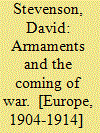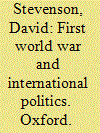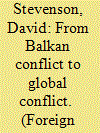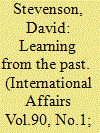| Srl | Item |
| 1 |
ID:
006831


|
|
|
|
|
| Publication |
Oxford, Clarendon Press, 1996.
|
| Description |
xi, 463p.Hbk
|
| Standard Number |
0198202083
|
|
|
|
|
|
|
|
|
|
|
|
Copies: C:1/I:0,R:0,Q:0
Circulation
| Accession# | Call# | Current Location | Status | Policy | Location |
| 038815 | 940.3112/STE 038815 | Main | On Shelf | General | |
|
|
|
|
| 2 |
ID:
069393


|
|
|
| 3 |
ID:
034790


|
|
|
|
|
| Publication |
Oxford, Oxford University Press, 1988.
|
| Description |
x, 392p.: maps.Hbk
|
| Standard Number |
0198730497
|
|
|
|
|
|
|
|
|
|
|
|
Copies: C:1/I:0,R:0,Q:0
Circulation
| Accession# | Call# | Current Location | Status | Policy | Location |
| 029286 | 940.4/STE 029286 | Main | On Shelf | General | |
|
|
|
|
| 4 |
ID:
117951


|
|
|
|
|
| Publication |
2012.
|
| Summary/Abstract |
This article analyses the evolution of permanent fortifications in Europe between 1870 and 1914. Despite the introduction in the 1880s of high explosive shells, intensive construction continued until the eve of war. Fortifications figured prominently in armaments budgets and in offensive as well as defensive strategic planning, while their design changed radically. Nonetheless, the pattern of development worked against the Central Powers. Austria-Hungary concentrated against Italy at the expense of the Balkans and Galicia; Germany concentrated on Alsace-Lorraine, neglecting the east until 1912. Whereas France modernised its eastern fortresses, Belgium did little, enticing Germany into the envelopment strategy that would draw Britain into the First World War.
|
|
|
|
|
|
|
|
|
|
|
|
|
|
|
|
| 5 |
ID:
103939


|
|
|
|
|
| Publication |
2011.
|
| Summary/Abstract |
This essay reassesses the process whereby between August 1914 and the end of 1917, all the most powerful countries of the day became belligerents in the First World War. It examines the three waves of decisions to intervene and offers generalizations about the process, comparing the early twentieth century with more recent periods.
|
|
|
|
|
|
|
|
|
|
|
|
|
|
|
|
| 6 |
ID:
131399


|
|
|
|
|
| Publication |
2014.
|
| Summary/Abstract |
This article is based on an inaugural lecture for the Stevenson Chair in International History, given at the London School of Economics (LSE) in October 2012. It re-examines the origins in Britain in the 1920s of the academic discipline of international history, focusing on the partnership between the LSE and Chatham House. It highlights the differences among the discipline's founders between broader and more tightly defined conceptions of its subject matter and scope, identified respectively with Arnold J. Toynbee on the one hand and with Harold Temperley and Charles Webster on the other. It also underlines the founders' agreement about international history's practical applicability, particularly for analysing and even for helping to prevent the outbreak of major wars. It explores the theme of 'learning from the past' by investigating the interconnection between the diplomatic crises of July-August 1914 and October 1962, reappraising John F. Kennedy's use of history to inform statesmanship. The article points to a recurrent pattern in the international conjunctures of 1914, 1939 and 1962 that may be replicating itself again today. It concludes that a knowledge and understanding of international history can indeed yield insights of practical value, though must be drawn on flexibly and with imagination.
|
|
|
|
|
|
|
|
|
|
|
|
|
|
|
|